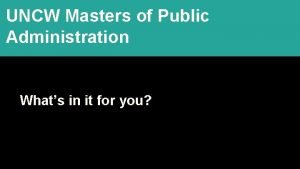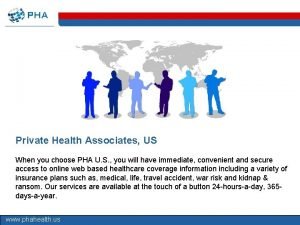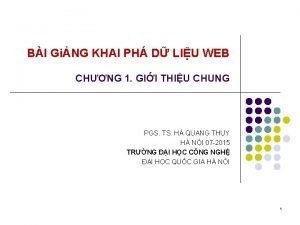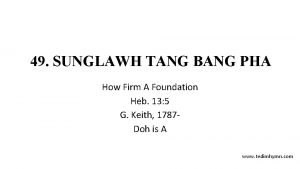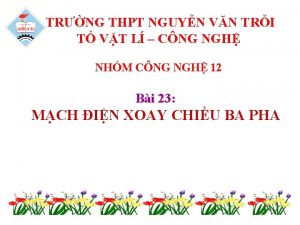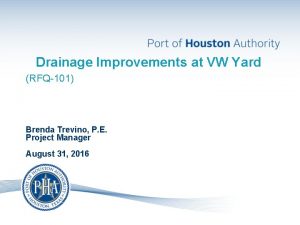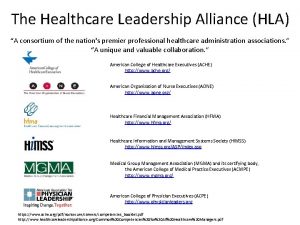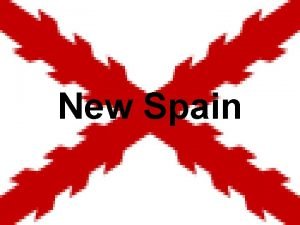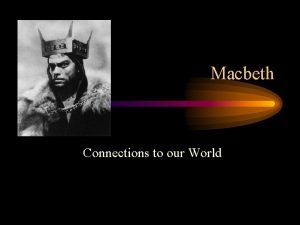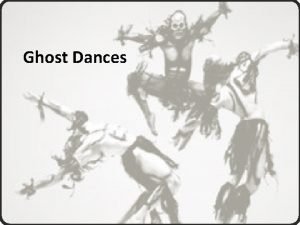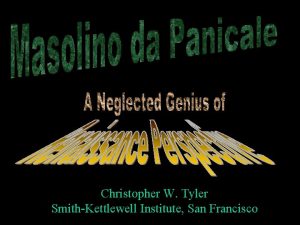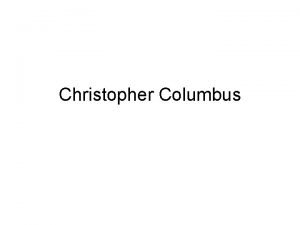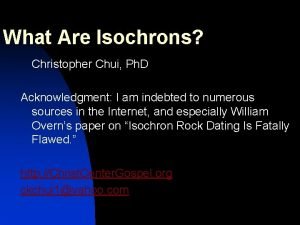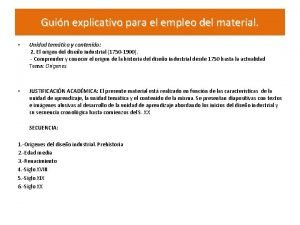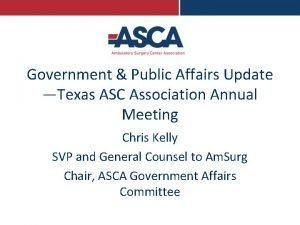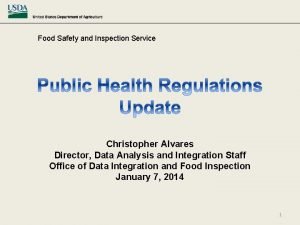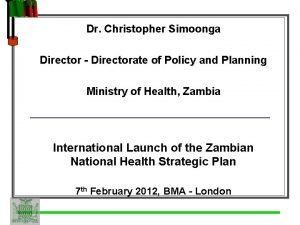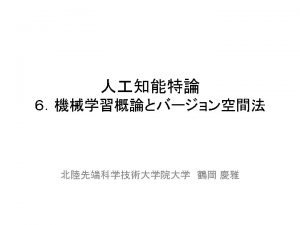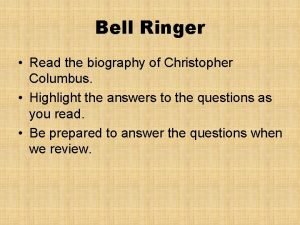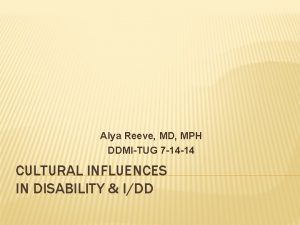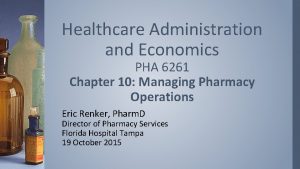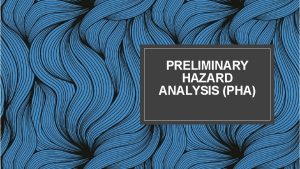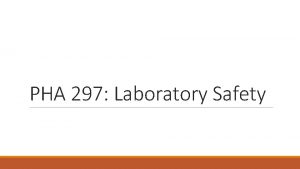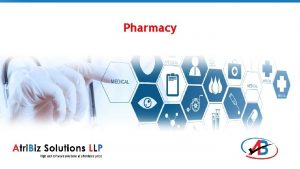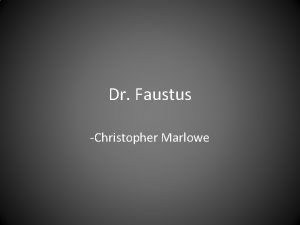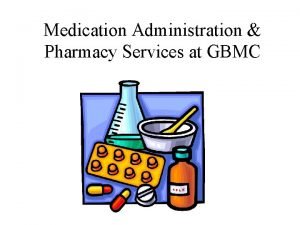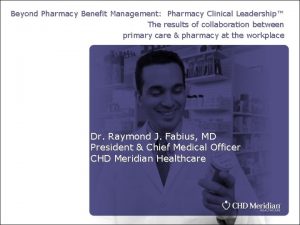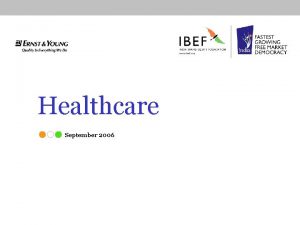Healthcare Administration Economics PHA 6261 Pharmacy Leadership Christopher
















































































- Slides: 80

Healthcare Administration & Economics PHA 6261 Pharmacy Leadership Christopher Lynch, Pharm. D, MEd CDR, MSC, USN (ret)

Pharmacy Leadership & Management in Pharmacy Practice, 2 nd ed Principles & Characteristics of Leadership (Ch. 1) Understanding & Working in the Organization (Ch. 2) The Importance of Vision, Inspiration, & Strategic Planning and Getting it Done (Ch. 3) Leading Culture, People & Strategic Planning (Ch. 4) Leading Change & the Pharmacy Enterprise (Ch. 5)

Pharmacy Leadership Principles & Characteristics of Leadership (Ch. 1) What is the difference between leadership and management? Can you tell the difference?

Pharmacy Leadership “Managers are people who do things right and leaders are people who do the right thing. ” “Managers typically focus on performing the job on behalf of the organization…” “Leaders consider the needs of the organization as well as the needs of the people they are leading. ” “Leaders are not always managers, and managers are not always leaders. ” “Those who display characteristics of both are typically best for organizations. ” (and professions)

Pharmacy Leadership “Leadership, the ability to influence the actions of others, is based on the interaction of three elements: the leader, the person or persons being led, and the situation in which both exist. ”

Pharmacy Leadership The Purpose of leadership: To help individuals, groups, and organizations grow and develop. Individuals – need leaders to help their personal and professional growth Groups – need leadership to promote teamwork, cohesion and reach mutual goals Organizations – need leadership to ensure activities align with collective vision & expectations to achieve desired outcomes

Pharmacy Leadership Theories Leadership has been studied…a lot! Think of people you would consider a leader? What are some traits/characteristics of a leader? Were these traits/characteristics inherent, learned, or both? No single trait/characteristic or combination fully fits

Pharmacy Leadership Theories What separates leaders from followers? Historically, researchers & theorists looked at the task -relationship approach; the situation and relationship interaction of the leader & follower Learnable behaviors were theorized for different situations/environments (Kersey & Blanchard): -Situational -Contingency

Pharmacy Leadership Situational Leadership Leader assumes a role/style based on the situation and the readiness level of the followers Readiness: willingness, confidence, & ability to do a particular task Leadership styles (4) depends on the motivation and functionality of the followers & task complexity: -Telling -Selling -Participating -Delegating

Pharmacy Leadership Situational Leadership Styles Telling – best for inexperienced followers; leader gives direction and encouragement Selling – best for experienced/seasoned followers who require retooling or convincing of a better way Participating – followers have skillset, so leader is more supportive; highly encouraging (coaching) Delegating – followers are willing and able to take responsibility for completing the task(s)

Pharmacy Leadership Situational Leadership Theories Involve the follower’s perception of the task Stress the complexity of the leader-follower relationship Cannot predict what exact leadership/personal skills are needed Only identify how a leader should behave; not what makes a good leader

Pharmacy Leadership Current Leadership Research Situational Theories cannot predict traits of leaders This led to studying the difference between leaders and managers Researchers again looked at personality traits as markers of leadership The strongest predictor of leadership potential is having organizational vision

Pharmacy Leadership Current Leadership Research You MUST have vision to be a leader You also must be able to facilitate a shared vision This is done by valuing human resources (i. e. people); those in your charge People are the most important asset in your charge Theories (2): -Transformation Leadership -Emotional Intelligence

Pharmacy Leadership Transformational Leadership Developed in late 1970’s Not specific behavior, but a process which raises the leader & follower to higher levels of motivation and ethical behavior Driven by a desire for fairness – something better Involves a shared vision & self actualization needs

Pharmacy Leadership Transformational Leadership This style helps build high quality, highly effective teams with strong relationships between leaders and followers (bonds) Leaders facilitate a shared purpose by creating a vision of the future that is attractive to followers; then challenge followers to perform Is usually intellectual and emotional, with questioning of long-standing beliefs and traditions which brings new ideas and commitment/loyalty (ownership vs buy-in)

Pharmacy Leadership Emotional Intelligence Introduced by Daniel Goleman “The ability to recognize one's own and other people's emotions, to discriminate between different feelings and label them appropriately, and to use emotional information to guide thinking and behavior” Emotional needs, drives & true values of a person Largely determines leaders success

Pharmacy Leadership Emotional Intelligence Described in 4 domains: Self-Awareness -recognizing personal emotions & motivations and how they affect others Self-Management -managing emotions (especially disruptive emotions); creates trustworthiness and integrity Social Awareness -sense the emotions of others and empathize (individuals, groups and organizationsclimate) Social Skill (relationship management) -building relationships, developing teams & collaborative groups; managing conflicts; using communication as a tool to influence others

Pharmacy Leadership Emotional Intelligence & Leadership Styles 6 styles developed by Goleman No one style used exclusively; all have some use Affiliative Authoritative Coaching Coercive Democratic Pacesetting Feedback & rewards Self-confidence empathy Team building Delegation Personnel development Demand compliance Participation Consensus Buy-in Autocratic High Standards -Social Awareness -Social Skill -Self -Awareness -Social Skill -Self. Management

Pharmacy Leadership “The need for leadership in pharmacy is growing as the profession expands its horizons and takes on more patient-focused responsibilities. ” “Effective leadership in pharmacy is critical to having an innovative practice setting, and to advancing the practice of pharmacy. ” “The changing nature of pharmacy practice must be led, not just managed. ” “Regardless of a pharmacist’s practice setting, knowledge of the leadership and management skills will aid them in serving the profession throughout their careers. ”

Pharmacy Leadership Do you see yourselves as being leaders in the pharmacy profession, or do you think you’re too young, or it’s not your job? Leadership begins with you! You can’t lead with a bad attitude! Before you can lead others, you must be able to lead yourself. You can’t lead yourself until you know yourself. You can’t lead others until you know them. Leadership is needed at all levels…ENGAGE!

Pharmacy Leadership & Management in Pharmacy Practice, 2 nd ed Principles & Characteristics of Leadership (Ch. 1) Understanding & Working in the Organization (Ch. 2) The Importance of Vision, Inspiration, & Strategic Planning and Getting it Done (Ch. 3) Leading Culture, People & Strategic Planning (Ch. 4) Leading Change & the Pharmacy Enterprise (Ch. 5)

Pharmacy Leadership Leading & Managing Health-Care Professionals Distinct from leading other professionals: -human beings involved -high level of precision -high level of knowledge -stakes are high -quality is essential -high level of skill Basic contribution of Health Professionals is intellectual in nature (it’s all about knowledge!) Meaning of the word “Profession”? Pharmacists “profess” to be medication therapy experts, committed to optimal (quality) outcomes

Pharmacy Leadership Leading & Managing Health-Care Professionals Management is a process in which inputs are transferred by managers into desired outputs Management process is comprised of 5 functions -Covert Leadership -Identifying Influencers -Motivating Professionals -Rewards & Reinforcement -The Importance of Communication Think of functions as individual steps, not in series, but as part of a continual process

Pharmacy Leadership Leading & Managing Health-Care Professionals Covert (Subtle) Leadership -Professionals generally require little direction & supervision -Think of an orchestra conductor (manages the nuances) Identifying Influencers -Influential individuals not in leadership roles -Powerful allies or foes (must get them onboard) Motivating Professionals -Know what appeals to them (top 5 things) -Key to promoting a strong and loyal workforce

Pharmacy Leadership Leading & Managing Health-Care Professionals Rewards & Reinforcement -Different from motivation (external, not internal) -Need for acknowledgment & recognition -Be fair & consistent The Importance of Communication -Knowledge is power, but communication is key! -Key determinant in an organization achieving objectives -Listen, listen!

Pharmacy Leadership When Professionals Become Managers Very few people start out as managers Strong performance in a specialty = management Peter Principle – “in a hierarchy, every person tends to rise to their level of incompetence. ” “the art of management is learned on the job” Relative application of management skills over time

Pharmacy Leadership The Manager’s Role Availability & Accessibility are critical! Listening is great strategy to solve problems Be an advocate for subordinates Be cautious when giving out advice No simple strategies for managing professionals

Pharmacy Leadership Understanding & Working in the Organization (Ch. 2) “The manner in which organizations are put together clearly affects how they function. ” “An organization is a group of individuals structured to work together to achieve common goals. ” “The formal organizational structure is usually depicted by an organizational chart. ”

Pharmacy Leadership Classical Organizational Theory Described by Max Weber in early 1900’s and expanded by Henri Fayol Based on scientific method of analyzing processes & procedures to provide the most efficient means of organizing individuals for maximum productivity 14 Points/Principles of Organization/Management Only focusing on: Specialization of Labor, Unity of Command, and Scalar Chain (of command)

Pharmacy Leadership Specialization of Labor Places individuals into categories based on job functions to increase productivity Common in Pharmacy Practice (i. e. Community, Institutional, Long-term-care, etc. ) Unity of Command & Scalar Chain (of command) Hierarchy (lines) of authority needed for structure and to know who’s the boss Should only be one boss (unity of command)

Pharmacy Leadership Power & Authority Max Weber defined power as, “the possibility of imposing one’s will upon the behavior of others. ” In the context of organizations, “power is the individual’s capacity to move others, to entice others, to persuade and encourage others to attain specific goals or to engage in specific behavior; it is the capacity to influence and motivate others” 5 types of power: -Reward -Expert -Coercive -Legitimate -Referent (charismatic)

Pharmacy Leadership Formal vs. Informal Power Formal - powers of position -Legitimate power is based on one’s position -Reward & Coercive powers are conversely related Informal – personal powers -Expert power is derived from one’s knowledge or expertise -Charismatic power is an interpersonal skillset

Pharmacy Leadership Managing with Power Individuals are reluctant to use their power (especially in Health-Care) Too much time spent in decision-making process (analysis paralysis) Power needs to be used (decisions made) and then time spent adjusting as needed Power & Influence are the tools needed to get things done (leaders must utilize)

Pharmacy Leadership Modern Organizational Theories More managing people (behavior) than processes Theories X, Y, and Z (Douglas Mc. Gregor) Theory X – people inherently dislike work and need to be coerced into performing duties (job security). Theory Y – people want to exercise self-direction/control and accept additional responsibility; job commitment is a function of rewards and not just job security. Theory Z – similar to X & Y, but emphasizes attitudes and behaviors of the worker in which a large amount of trust & responsibility is placed. Success and failures are shared amongst workers and management

Pharmacy Leadership Organization Structure Types Rigid vs. Loose Mechanistic Organizations – traditional, most common, clearly defined lines of authority and tasks, centralized decision making Matrix Organization – dual authority system based on functional (project) and departmental lines (2 managers). Violates unity of command principle Organic Type – (i. e. Multidisciplinary Team), somewhat like bureaucracy (physician leading), but more flexible. The patient (or goal) is the focus. Potential for conflict.

Pharmacy Leadership The C-Suite Group of individuals at the top of the organization CEO, COO, CFO, CIO, Chief of Staff, DNS, (what about pharmacy…CPO? ) Pharmacists must be aware of C-Suite priorities (big picture) and how pharmacy fits in it/can help Must communicate with C-Suite Pharmacy Strategic Plan and Plan-of-Action & Milestones (POA&M)

Pharmacy Leadeship QUESTIONS? sparks 2 scripts@gmail. com 904 -718 -8054 (mobile)

Healthcare Administration & Economics PHA 6261 Pharmacy Leadership Christopher Lynch, Pharm. D, MEd CDR, MSC, USN (ret)

Pharmacy Leadership & Management in Pharmacy Practice, 2 nd ed Principles & Characteristics of Leadership (Ch. 1) Understanding & Working in the Organization (Ch. 2) The Importance of Vision, Inspiration, & Strategic Planning and Getting it Done (Ch. 3) Leading Culture, People & Strategic Planning (Ch. 4) Leading Change & the Pharmacy Enterprise (Ch. 5)

Pharmacy Leadership Review (Ch. 4) Leaders set visions, obtain “buy-in”, and inspire. Leaders lead the culture, people, & the strategic plan that directs actions toward achieving the vision. Organizational culture is the belief & behavior that determine how its people interact & handle outside transactions. The leader sets the values and expectations for the organization…hopefully, based on honesty and ethical behavior. The number one job of pharmacy leader is to make the pharmacy successful which means achieving the vision. MUST have a strategic plan to achieve the vision.

Pharmacy Leadership The Importance of Vision, Inspiration, & Strategic Planning and Getting it Done (Ch. 3) Why are some pharmacies innovative and exciting places to work? Why are some boring and even dangerous?

Pharmacy Leadership Outstanding Leadership Quotes Characteristics of Great Leaders are not necessarily charismatic or have a participative style. Leadership is about setting a vision, being inspirational, and achieving the vision. Leaders also develop teams and define values. It’s all about the VISION!

Pharmacy Leadership Great Leaders Create Vision So important! Definition of visioning – (Webster) “the act of forming mental images. ” Images Dreams Goals Foolishness? All great leaders dreamed and practiced visioning Visioning and dreaming are powerful!

Pharmacy Leadership Creating a Vision Being a visionary is the ability to identify what is most important, to see what others may not see, and to understand & communicate why the vision is worth pursuing. Demands discipline (3 steps) Begin with end in mind (Covey’s 7 Habits - #2) Removes barriers & restrictions (freely create) Write it down (more likely to occur!)

Pharmacy Leadership Inspiration & “Buy-in” Have a vision? Now what? Who do you need to inspire (stakeholders)? Buy-in is all about the “why”, not the “what” & “how” The “reason” for the vision is what sells it Great leaders create vision & inspire others to “buy-in” to their vision…which leads to attaining the vision “Buy-in” versus “Ownership” (see article)

Pharmacy Leadership Communicating & Enforcing the Vision must be relatively short & simple to understand The 60 second elevator speech -picture -purpose -plan -request Make the speech about the listener, challenging, and actionable Leaders plan & find opportunities to share their vision regularly with stakeholders Storytelling

Pharmacy Leadership Creating a Strategic Plan Have a vision & buy-in? Now what? A Strategic plan is necessary to achieve the vision Leaders must promote teamwork & enthusiasm to accomplish goals Goals must be important to stakeholders It’s the team’s responsibility to create the strategic plan Strategic Plans provide the road map for action plans, facilitates teamwork, & helps with buy-in/ownership

Pharmacy Leadership SWOT Analysis Definition – An environmental scan that summarizes the organization’s Strengths, Weaknesses, Opportunities, and Threats Identifies challenges Provides clues how to achieve vision Example

Pharmacy Leadership Consensus & the Strategic Plan Start with the end in mind, and work your way back in a straight line to the present. Along the line is the plan – the work that must be done to achieve the vision. The team generates the ideas for the plan of work. Everyone’s ideas count & are equally considered Nominal Group Technique (NGT) pg. 44

Pharmacy Leadership Drafting the Strategic Plan First draft is usually done by pharmacy/project manager or clinical coordinator (not the leader) Strategic Plan starts with written mission and vision statements (what are we here for & where do we want to go). Develop (set) goals & objectives (milestones) Develop a POAM (Plan(s) of Action & Milestones)

Pharmacy Leadership Getting it Done Leaders must not only have a vision & obtain buy-in, but must also keep it simple (KISS), stay focused and determined to achieve the vision. -Keep it simple or you’ll lose the stakeholders (and yourself!) -Stay focused on what is important (3 -4 things) -Stay determined to achieve the vision (distractions) -Assign responsibility (COO, Associate Pharmacy Director) -Monitor progress & set time/deadlines -Celebrate successes (even the little stuff!)

Pharmacy Leadership Summary Great leaders are visionary, inspiring, & get the job done! Create a vision and inspire “buy-in” Record and reinforce the vision Develop a strategic plan to achieve the vision Stay focused & determined to achieve the vision Assign responsibility & timelines and monitor closely Recognize/celebrate individual and team successes

Pharmacy Leadership Questions for Pharmacy Leaders Do I have a clear vision for my pharmacy (in writing)? Can I explain my vision in a 60 second elevator speech? Do the stakeholders understand the vision & buy-in? Is there a strategic plan for the vision? Are the stakeholders involved/assigned? Is the plan making progress toward the vision? What is next?

Pharmacy Leadeship QUESTIONS? sparks 2 scripts@gmail. com 904 -718 -8054 (mobile)

Healthcare Administration & Economics PHA 6261 Pharmacy Leadership Christopher Lynch, Pharm. D, MEd CDR, MSC, USN (ret)

Pharmacy Leadership & Management in Pharmacy Practice, 2 nd ed Principles & Characteristics of Leadership (Ch. 1) Understanding & Working in the Organization (Ch. 2) The Importance of Vision, Inspiration, & Strategic Planning and Getting it Done (Ch. 3) Leading Culture, People & Strategic Planning (Ch. 4) Leading Change & the Pharmacy Enterprise (Ch. 5)

Pharmacy Leadership Leading Change & the Pharmacy Enterprise (Ch. 5) How much of the GDP does Healthcare make up in the United States? Where does the United States rank in the world for health outcomes?

Pharmacy Leadership Introduction The world is changing rapidly & companies must keep up or perish (health-systems are companies!) 45 million w/o health insurance b/f Affordable Care Act U. S. spends $7 k/person/yr; Cuba spends $300/person/yr Government reimbursement for hospital � 30% (approx) Demand for �Quality, Safety & Revenue; � Costs

Pharmacy Leadership Mandate for Change No one is happy with current healthcare system Most Americans do not have a regular physician Care is not convenient nor accessed consistently Doctors have very limited time to communicate (listen) High rates of chronic conditions & improper treatment Frequent medical & medication errors Healthcare is expensive! Can Pharmacy help?

Pharmacy Leadership Leading Change Very important skill for leaders The most important part of a strategic plan Half of all major change efforts result in failure Hundreds of “change” models out there So why do change efforts fail? Change process is a series of steps that requires time!

Pharmacy Leadership The Change Process John Kotter’s, Leading Change (8 reasons change fails) Not having a great enough sense of urgency Not having a guiding coalition with enough power Lacking vision Under-communicating Not removing obstacles Not planning for and creating short-term wins Declaring victory too soon Not anchoring changes in the organizational structure

Pharmacy Leadership Sense of Urgency Most basic 1 st step of the process Organizations fail b/c management is paralyzed Focus is on minimizing risk; keep current systems in place Change (def) – is about creating new systems which demands leadership…not management Change is hard, even if it is a good idea Can’t grow without change; can’t change w/o pain/fear

Pharmacy Leadership Guiding Coalition Have urgency…now what? A powerful coalition is needed to drive change forward Bell curve of change readiness (Diffusion of Innovation) Laggards (Naysayers) actively & passively resist Keep the people on the left informed & motivated Don’t spend too much time on “Laggards” (common mistake) Make the change clear (pros/cons) & hold people accountable

Pharmacy Leadership Vision Winning hearts & minds! Goes beyond numbers, clarifies organizational direction Has to offer something better than now Articulate in 5 mins or less (understanding & interest) Communication People won’t change unless they believe it’s worth it Must have a persuasive communication campaign Clearly articulate why new direction is best; get feedback!

Pharmacy Leadership Obstacles The best of plans can change (anticipate) Leaders job is to clear the obstacles (power & influence) Celebrate Important to celebrate short-term wins to keep momentum Build celebrations into the plan/process Will keep staff engaged and motivated Helps prevent going back to the “old ways”

Pharmacy Leadership Declaring Victory Be careful not to be in a hurry, or relax too soon! Leaders ensure “change” is embedded in the culture Helps maintain credibility (i. e. OIF/OEF) Anchoring the Change “sticks” when it becomes “the way we do things around here. ” (i. e. Culture of Change) Essential to ensure the “change” doesn’t drift away and things go back to “base course” when the pressure is off

Pharmacy Leadership The Change Process Someone decides to make a change & someone drives the change to success The Change Leader creates the vision and sense of urgency for change The Change Agent develops & facilitates the change Change Management: Plan & Performance “Plan your work, then work your plan. ”

Pharmacy Leadership The Change Model Developed by Elaine Biech Works in any change situation Very streamlined & straightforward Provides structure to lead & facilitate change Utilizes (6) steps: -Challenges the current state -Activates commitment -Guides implementation -Harmonizes & aligns leadership -Nurtures & formalizes a design -Evaluates & institutionalizes the change

Pharmacy Leadership Challenge the current state Requires thoughtful preplanning & action The leader must: Collect & analyze data to support the new position Determine organizational readiness for the change Establish change management roles Build a solid business case to support the change idea

Pharmacy Leadership Harmonize & Align Leadership Align change initiatives (strategic plan) with the organization’s overall strategic plan Coalition VIEW: Leaders who are Visionary, Inspiring, Enthusiastic, & Wise Ensure change implementation team is needed early to define strategies, sanctions, processes, & provide needed resources Team composition should have: credibility & expertise; from critical areas (stakeholders); and the right attitude (enthusiastic, problem-solvers & persistent)

Pharmacy Leadership Activate Commitment A change/implementation plan fills in the details of the change for people so things can move ahead Implementation Plan is a communication tool that makes the change seem “real” and attainable Proves that your not just “winging it” Plan includes mechanism for feedback Plan to celebrate those short-term/long-term wins

Pharmacy Leadership Nurture & Formalize Your Design Look at implementation plan to identify any issues that might hinder the change effort Identifies needed skillsets, time, & competing priorities Guide Implementation Develop tools/metrics to guide & measure the process Pay attention to: handoff points, promote short-term wins, keep stakeholders informed & engaged and thank them, deal with rumors and naysayers up front

Pharmacy Leadership Evaluate & Anchor the Change Evaluate the change to ensure it has become, “The way business is done now. ” This step is often skipped (why? ) Run the risk of returning to old ways if not done Brings closure to the change process Helps to improve future change process Opportunity to celebrate success!

Pharmacy Leadership Incremental versus Transformational Change Not all change is the same Incremental change has been the norm Does not require a change in thinking, only learning Results in same or little changes Transformation change is needed in healthcare Requires a change in thinking, new behaviors Results in breakthrough changes & performance

Pharmacy Leadership The Business of Pharmacy & Change Healthcare wants/needs to: � Quality & Revenue; � Risk & Expense So how can Pharmacy help? Drugs, Drugs!!! Also advances the PPMI as well Does “Healthcare” (i. e. C-suite) view Pharmacy as the answer?

Pharmacy Leadership Branding Examples Personal – the value you’re able to consistency deliver to those you serve (not self promotion) Organizational – the value the organization is able to consistently deliver to those it serves Significance – essential to leaders and successful organizations http: //www. forbes. com/sites/glennllopis/2013/04/08/personal-branding-is-aleadership-requirement-not-a-self-promotion-campaign /

Pharmacy Leadership Challenge/Change the Current Pharmacy Brand Pharmacy needs to change its brand! Pharmacy needs a familiar brand (examples) Pharmacy should mean quality Pharmacy should mean safety and effectiveness Pharmacy should mean value Redefine the view & expectations of pharmacy

Pharmacy Leadership Selling the Change Use the Change Model/Process Be able to use skills to sell the change to decision makers and include pharmacy at the big table Communicate clearly & memorably (100 -200 words) Frame your message Be persuasive and make sure the idea resonates Advocacy is everyone’s responsibility

Pharmacy Leadership Summary “it was the best of times, it was the worst of times. ” -Charles Dickens Healthcare is changing, and new and innovative ways must be embraced…a new way of thinking (change) Pharmacy is poised to lead the change Use the Change Model/Process to develop a strategic plan and then execute/accomplish it Lead, manage, advocate…don’t do nothing!

Pharmacy Leadeship QUESTIONS? sparks 2 scripts@gmail. com 904 -718 -8054 (mobile)
 Ift6261
Ift6261 Ift 6261
Ift 6261 Do you want to dance reported speech
Do you want to dance reported speech Healthcare and the healthcare team chapter 2
Healthcare and the healthcare team chapter 2 Healthcare and the healthcare team chapter 2
Healthcare and the healthcare team chapter 2 Uncw mpa
Uncw mpa Uic healthcare administration
Uic healthcare administration Healthcare administration in athletic training
Healthcare administration in athletic training Health administration definition
Health administration definition Pha associates
Pha associates Lược đồ quang trung đại phá quân thanh
Lược đồ quang trung đại phá quân thanh Thiết kế nghiên cứu khám phá
Thiết kế nghiên cứu khám phá Cách pha chế dung dịch canxi hiđroxit
Cách pha chế dung dịch canxi hiđroxit Quy trình khai phá dữ liệu
Quy trình khai phá dữ liệu Vua nào thần tốc quân hành
Vua nào thần tốc quân hành Rubisco enzim
Rubisco enzim Heb pha
Heb pha Cách nối nguồn hình sao
Cách nối nguồn hình sao Vw pha
Vw pha Ihi leadership alliance
Ihi leadership alliance Healthcare leadership alliance
Healthcare leadership alliance Va healthcare leadership talent institute
Va healthcare leadership talent institute Economics and business economics maastricht
Economics and business economics maastricht Econ213
Econ213 Transactional leadership and transformational leadership
Transactional leadership and transformational leadership What is adaptive leadership theory
What is adaptive leadership theory Capable but cautious performer
Capable but cautious performer Christopher ding
Christopher ding Michael buehler
Michael buehler Christopher hirata
Christopher hirata Cma cgm christopher columbus
Cma cgm christopher columbus Hoe is biggie overleden
Hoe is biggie overleden Gerald gallego
Gerald gallego Devion christopher brooks
Devion christopher brooks Christopher p cannon
Christopher p cannon When did christopher columbus discover america
When did christopher columbus discover america Christopher dalley
Christopher dalley How is christopher tony sopranos nephew
How is christopher tony sopranos nephew Finally, it has arrived
Finally, it has arrived When did columbus sail the ocean blue
When did columbus sail the ocean blue Christopher hirata
Christopher hirata Ghost dances christopher bruce facts
Ghost dances christopher bruce facts Christopher tingwell
Christopher tingwell Facts about john cabot
Facts about john cabot Christopher janietz
Christopher janietz Chris scott kyle
Chris scott kyle Sheeran edward christopher
Sheeran edward christopher Dr faustus synopsis
Dr faustus synopsis Christopher geyer
Christopher geyer Christopher s. bretherton
Christopher s. bretherton Christopher w tyler
Christopher w tyler Dr christopher morrissey
Dr christopher morrissey Christopher reeve spinal cord injury level
Christopher reeve spinal cord injury level Christopher paul curtis interview
Christopher paul curtis interview Christopher marlowe biography
Christopher marlowe biography Where did columbus land
Where did columbus land Christopher columbus
Christopher columbus Christopher ryu
Christopher ryu Christopher sayeski
Christopher sayeski What are isochrons
What are isochrons West memphis 3 crime scene photos
West memphis 3 crime scene photos Blank verse shakespeare
Blank verse shakespeare Christopher leydon
Christopher leydon Christopher tingwell
Christopher tingwell Hyperzane
Hyperzane Christopher dresser teapot
Christopher dresser teapot Christopher kelly amsurg
Christopher kelly amsurg Christopher alvares
Christopher alvares Who six building blocks
Who six building blocks Christopher slatter
Christopher slatter Comic scenes in dr faustus
Comic scenes in dr faustus Christopher m bishop
Christopher m bishop Christopher lynch tenor
Christopher lynch tenor Christopher columbus biographical information
Christopher columbus biographical information When did christopher columbus sail
When did christopher columbus sail Christopher columbus
Christopher columbus Christopher boffoli
Christopher boffoli Dr christopher greenman
Dr christopher greenman Christopher columbus
Christopher columbus Matthew reeve alya reeve
Matthew reeve alya reeve Snow white's step mother
Snow white's step mother





